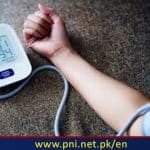ISLAMABAD, May 14 (Online): A new study proposes a type of blood test for predicting cerebral small blood vessel disease and, thus, the likelihood of a stroke or cognitive decline in the future. The insight presented by the study is that people with high levels of five specific molecules in the interleukin-18 network are more likely to experience such events. More work is needed to validate the study’s findings. While there is currently no cure for cerebral small blood vessel disease, experts suggest heart-healthy practices may help since the vessels are part of the cardiovascular system. A new study raises the possibility of a blood test that can predict the likelihood of having a stroke or experiencing cognitive decline in the future. The authors of the study identified a network of inflammatory molecules in the blood that allows the scoring of a person’s risk of developing cerebral small vessel disease, the frequent cause of strokes and cognitive decline. The development of such a test would be an important step forward. As of now, cerebral small vessel disease (CSVD) can best be diagnosed with an MRI, and the risk of stroke and cognitive decline derived from calculations encompassing family history, demographic details, and other risk factors, including lifestyle. The targets of the study are inflammatory molecules known as the interleukin-18, or IL-18, network that includes proteins and signaling molecules for fighting off infections. These molecules have been linked to CSVD, and to strokes. However, their levels fluctuate as a result of immune responses to infections as well as autoimmune disorders, making them difficult to measure. In 2020Trusted Source, researchers linked five of these molecules to vascular brain injuries detected in MRI brain scans. The new study utilized data from the Framingham Heart StudyTrusted Source that has followed the medical history of thousands of residents in the city of Framingham, Massachusetts since 1948. The final cohort of individuals represented in the study consisted of 2,201 people, aged 45 or above. For each, blood samples existed, as well as MRI scans. This allowed the researchers to develop a model with which they could score individuals’ stroke risk — higher scores meant a higher risk. For those who scored in the upper 25%, the risk of stroke at some point during their lifetime was 84%. Others whose scores were elevated to a lesser degree had a 51%. The study is published in the journal StrokeTrusted Source. What is cerebral small vessel disease, how does it affect brain health? First author of the study, vascular neurologist Jason Hinman, MD, PhD, from UCLA Health, explained for Medical News Today that: “Cerebral small vessel disease is a significant risk factor for cardiovascular disease. It increases the risk for stroke and cognitive impairment yet often occurs silently.” “Small vessel disease typically refers to chronic and progressive damage to small arteries, called perforators, which branch off of large intracranial arteries and provide blood supply to the deep structures of the brain,” José Morales, MD, MSc, vascular neurologist and neurointerventional surgeon at Pacific Neuroscience Institute in Santa Monica, CA not involved in the study, also said. According to another expert, Jayne Morgan, MD, cardiologist and the Executive Director of Health and Community Education at the Piedmont Healthcare Corporation in Atlanta, GA, “[t]hese vessels can become occluded or narrowed, especially with age, and cause a reduced delivery of oxygen to the brain tissue.” Morgan, who, likewise, was not involved in the study, emphasized that: “In turn, this can lead to decreased brain activity and cell death resulting in dementia, stroke, difficulty with movement or speech, as well as cognitive decline.” Predicting CSVD is tricky, Morgan added, “[k]eeping in mind that the pathophysiology of CVSD involves several pathways, including the blood brain barrier, addressing predictive markers can be complex.” Hinman noted that even having previously identified the five stroke-risk molecules, measurement of any one of them can be difficult since “levels of inflammation go up and down in any one individual.” What is new in the study, he said, is that “those with high levels of all five of these molecules have evidence of cerebral small vessel disease and now, with this work, are at future risk of stroke in a quantifiable way.” “Many risk factors for CSVD are the same risk factors for heart disease,” noted Hinman, “such as smoking, diabetes, hypertension, and elevated cholesterol levels.” “Genetics also plays a big role,” said Morales. How to check for cerebral small vessel disease There are numerous indicators that a person may need a CSVD assessment. “Small vessel disease may present as silent strokes,” said Morales, “but may also cause symptoms such as lateralizing weakness, facial droop, sensory loss, cognitive impairment, or imbalance. These symptoms may be transient or may persist with improvement over time.” Morgan added that difficulties using or understanding language, as well as increasing and severe headaches, should also be brought to a physician’s attention. “It is imperative,” cautioned Morales, “for patients and family members that they do not minimize even mild stroke symptoms, and seek emergent medical attention by calling 911.” What a simple blood test could mean for stroke prevention As of now, the proposed blood test for individuals requires more research and development, said Hinman: “To make this clinically viable, we would ideally demonstrate the proactive ability of this biomarker to help prevent strokes prospectively rather than using retrospective data as we did here,” said Hinman. He would also hope to see cutoff values for the biomarkers with which providers and patients can easily interpret tests. “Finally, understanding the IL-18 network levels in a more diverse population is essential, and that work is underway in the DIVERSE VCID Study that we are participating in.” Morgan pointed out that while this study shows promise, all markers measured did not confer the same degree of positive predictability, with some conferring a heavier correlation weight than others. What to do if you have cerebral small vessel disease “While exercise has not been shown to retard the progression of CSVD,” Morgan said, “studies have shown that regular exercise does reduce all-cause mortality and cerebrovascular events.” Morales agreed, saying that “[u]p to 80% of strokes can be prevented by controlling for […] vascular risk factors, maintaining a healthy diet and lifestyle with regular exercise.” He also pointed out that “[e]stablishing continuity of care with a primary care physician can identify many of these risk factors early, and institution of preventative measures, whether they be pharmacologic intervention or lifestyle changes.”
Follow the PNI Facebook page for the latest news and updates.








